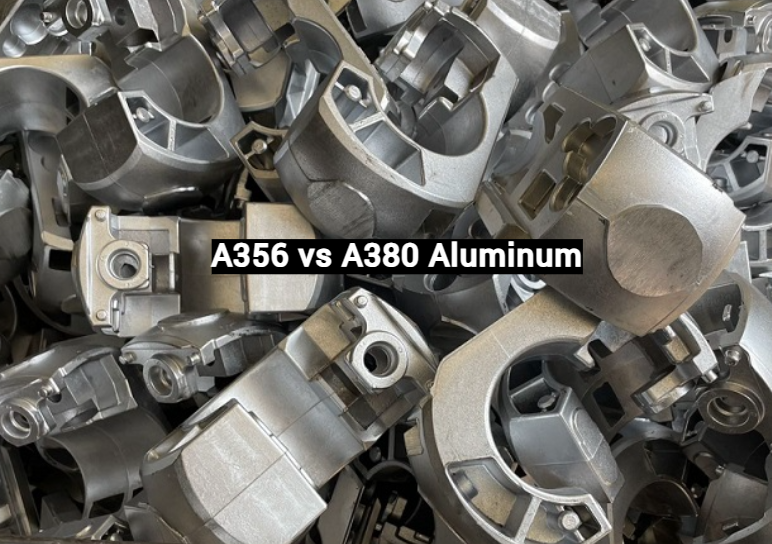Among the myriad options available, A356 and A380 emerge as the stalwarts, representing two distinct branches of cast aluminum alloys. Understanding the nuances between these alloys is crucial for industries seeking precision, durability, and specific mechanical properties in their cast products. In this A356 vs A380 guide, we’re going to discuss the differences between A356 and A380, about their casting methods, chemical compositions, mechanical properties, characteristics, and applications.
A356 vs A380 Aluminum – 5 Differences Between A356 & A380
Differences in Casting Methods
Cast aluminum alloy A356 is a typical aluminum silicon alloy. Casting method: Metal mold casting, sand mold casting, not suitable for die casting (unable to proceed perform heat treatment)
The cast aluminum alloy A380 is a representative of the aluminum silicon copper alloy series. Casting methods: sand casting, die casting, metal casting (limited to simple casting single piece).
Differences in Chemical Composition
Cast aluminum alloy A356: silicon Si: 6.5~7.5; Magnesium Mg: 0.25~0.45; Aluminum Al: Quantity.
Cast aluminum alloy A380: copper Cu 3.0-4.0; Silicon Si 7.5-9.5; Aluminum aluminum residue.
Differences in Mechanical Properties
Cast aluminum alloy A356: tensile strength ob (MPa): ≥ 220; Yield strength ob (MPa): ≥ 180; elongation δ 5 (%): ≥ 2;
Hardness (HB): 65-95. The mechanical properties are the values obtained after heat treatment strengthening. Heat treatment regulations fan: Quenching: 535+5 ° C, raising temperature for 2 hours, rising to 535, holding for 8-12 hours, 65 ° C water cooling, less than 45 seconds, annealing, aging or tempering: 180+5 ° C, 1 good temperature increase, insulation for 4-8 hours; Then air cooling.
Cast aluminum alloy A380: Elongation rate 85 (%): ≥ 3.5; tensile strength σ B (MPa): ≥ 320; Yield strength 160MPa; hardness (HB): ≥ 60 (5/250/30). The mechanical properties of the cast aluminum alloy are determined using standard tests. The parameters of the test rod produced under ideal die-casting conditions, rather than the mechanical performance values obtained from sampling from die-casting parts, are determined by the rod mold. Using die casting the numerical value of the main specimen is about 240MPa in tensile strength and about 2% in elongation. Aluminum castings obtained through gravity casting of aluminum alloy can achieve full mechanical performance requirements.
Differences in Characteristics
The casting performance of A356 aluminum alloy is excellent, with good fluidity, reduced wire shrinkage, low hot cracking tendency, and high air tightness. The resistance of A356 aluminum castings high corrosiveness, good weldability, average machinability of as cast aluminum castings, heat treatment strengthening, natural aging ability, high strength, good plasticity, with extremely high mechanical properties after heat treatment. However, this grade of aluminum alloy is not suitable for die casting, and even the aluminum castings produced by die casting cannot achieve T6 position.
Okay, why can’t we do T6 processing? The cast aluminum alloy A380 combines easy casting, high flexibility, strong pressure resistance, and good high-temperature splitting resistance, making it easy to machine, having good heat conduction and equal characteristics. However, due to its own copper content, hot cracking may occur during metal mold gravity casting. And because the material does not contain heat treatment magnesium is required, so this grade cannot undergo T6 treatment for strengthening.
Differences in Application
The cast aluminum alloy A356 is widely used in aviation pump accessories, automotive transmissions, pulleys, casings, volutes, brackets, and other heights strength stress mechanical accessories.
Cast aluminum alloy A380, like A356, is widely used, including engine mounts, chassis for motors and equipment, gearbox casings, and furniture accessories, generator casing, and manual tool accessories, etc.
Although there is a significant difference between cast aluminum alloys A356 and A380, they are both widely used and play a complementary role.


